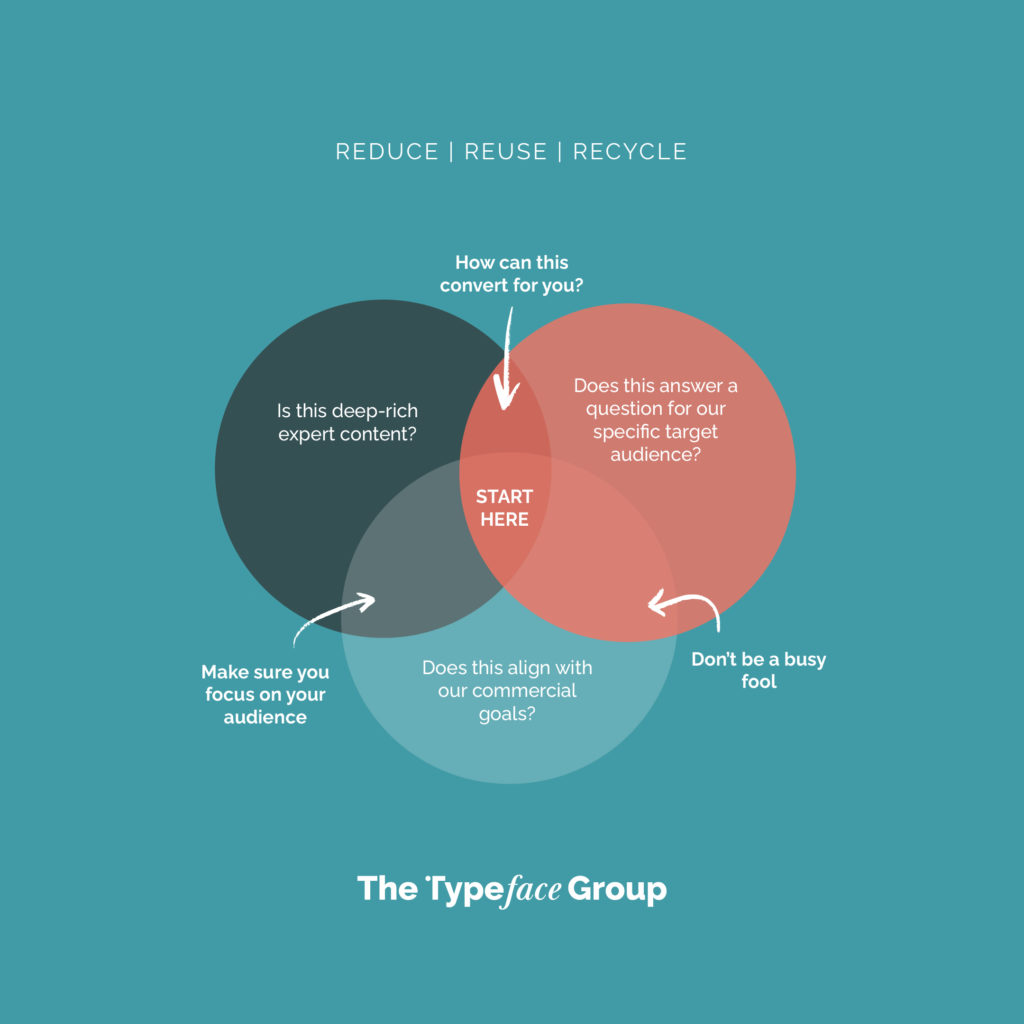In a world that’s getting louder and more cluttered by the day and one where we face constant challenges and uncertainty (think economic climate/recession), there’s never been a better time to tune inwards and focus on what really matters within your business.
“67% of UK SMB’s main priority will be to acquire new customers in 2023* However, with almost 60% of respondents reporting their marketing budgets will remain static or be slashed for 2023, there is a disconnect between the budgets and ambitious plans.” – MarketingTech
When the world around you feels unsteady, it’s tempting to try to produce more for less; less money, less time, less energy. Business decisions will likely be made rooted in panic and reaction, rather than ones of focus and proactivity. This can lead to a scattergun approach – trying to target everyone and cover all bases. And that’s a sure fire way to completely miss your business bullseye!
“Fear-based decision-making happens when you make decisions based on being afraid of a potential outcome. These decisions compound one another into what becomes an impossible cycle of trying to plug all the holes before the dam breaks”.
Ashley Janssen
Do less: Just make it better
It’s time to niche down. Trying to nail every marketing tactic and hit every channel won’t help you achieve your overall goals – it will only drain you of your time, energy and money while creating considerable waste.
To frame the benefits of niching, Seth Godin encourages us to market to our Minimum Viable Audience. The smallest group that could possibly sustain you in your work…
Reducing your output in favour of increasing quality will not only reduce your carbon impact, but you’ll also be in Google’s good books. The EEAT principle and the helpful content update call for expertise, experience, authority and trustworthiness.
If you’re unsure where to start, look at what you’ve already got with a content review.
Drop us your details to download
Want some quick wins to reduce, reuse, and recycle your marketing?
“the mistake people make who are trying to market a product, service, or themselves, is to make average stuff for average people, in a misguided attempt to please everybody.”
Seth Godin
Steps to reduce marketing waste
Focus on your value
Stop saying yes to everything and say no to all the little things that navigate you away from your purpose and value. For example, if your marketing and communications strategy has you targeting a myriad of different audiences, your marketing will inevitably become diluted and ineffective.
Reduce marketing waste by squeezing value
Once you’ve established your core content, squeeze as much value from it as possible. Remember, it can take up to 10 touchpoints for a customer to make a buying decision, so be bold in repurposing your message.
Convert written content into visual content
Take written content such as blog posts, articles, or social media posts and turn them into visual content such as infographics, videos, or images. This can attract a new audience and help reinforce the message in a more digestible format.
Update and republish old content
Revisit older content that performed well in the past, and update it with new information, statistics, and examples. Then republish it to bring it to the forefront again.
Create an ebook
If you have a series of blog posts or articles on a particular topic, you can compile them into an ebook. This provides a convenient and shareable resource for your audience while showcasing your expertise.
Turn webinars or podcasts into blog posts
If you have recorded them, you can transcribe them into written content, such as blog posts or articles. This can help reach a new audience who prefers reading to listening.
Use social media to repurpose content
Share snippets of long-form content on social media platforms like Twitter and LinkedIn. It’ll help increase engagement and provide easy-to-consume, bite-sized content.
Assess your content with these marketing metrics
To determine the actual value of repurposed or recycled content, you can look at the following metrics:
- Time on page: This metric measures how long a user spends on a page, indicating whether the content attracts and engages them.
- Bounce rate: This metric measures the percentage of users who leave a website after viewing only one page. A high bounce rate can indicate that the content is not resonating with the audience, while a low bounce rate suggests the content is relevant and engaging.
- Social media engagement: Look at likes, comments, shares, and click-through rates for your social media posts. These metrics provide insight into how well your content is received and whether it resonates with your audience.
- Conversion rates: If your content includes a call to action (CTA), track the number of users who take the desired action, such as filling out a form or purchasing your product/service. This will help determine your content's effectiveness in driving engagement and conversions.
- Returning visitors: Look at how many visitors return to your website or social media page after engaging with your repurposed content. This can indicate that they found value in the content and want to engage further with your brand.
By analysing these metrics, you can gain insight into which repurposed or recycled content is resonating with your specific audience and which is not, helping you to focus your efforts on the most effective content strategies. Read on to discover what else you can do to reduce the noise.
Drop us your details to download
Want some quick wins to reduce, reuse, and recycle your marketing?
Reduce the noise
It can be tempting during difficult times to slam on the breaks.
Don’t.
But don’t create content for the sake of it, either. This attitude (often born from panic) only adds to the noise. Instead, hone in on what is essential and effective.
Think battery-saving mode and actively reduce, reuse and recycle, squeezing every last bit of value from your spend.
Wasteful marketing increases your digital carbon footprint. Today, data centres (that power the internet) account for 2% of the world’s greenhouse gas emissions (GHG). Which is as much as the AIRLINE INDUSTRY!
Web Neutral Project founder, Jack Amend, calculates that powering the ‘average website’ produces 4,500 pounds of CO2 a year – the equivalent of driving the average new car for more than 10,000 miles.
The average web page produces 1.76g of CO2 per view, and the average email is 4g CO2.
So, before you put digital pen to pad, ask yourself these questions:
- Does this answer a question for your target audience?
- Does it align with your commercial goals?
- Is it deep-rich expert-led content?

There are clear benefits to repurposing your content to reinforce your message, but think about tailoring your content to each platform.
For example:
- Email: Instead of sending generic newsletters to your entire email list, segment your list based on interests or behaviours and send targeted emails that address specific needs.
- Blog: Instead of creating generic content that everyone else is writing about, focus on a specific niche or topic and provide unique insights or perspectives.
- Social media: Instead of posting random content to your channels, create a content calendar that aligns with your business goals and your audience’s interests. Use visual content like images and videos to grab attention and stand out.
Reducing marketing waste can make you 3x better
Being more considered, using SEO best practices, and adopting carbon-conscious marketing all overlap to improve customer experience, clarity of proposition. So, remember:
- Focus on quality over quantity: By taking a more considered approach to content creation, you’ll end up creating high-quality content that resonates with your audience and avoids the noise of irrelevant or low-quality content (which negatively impacts rankings, read why here). This can improve customer experience and make it easier for customers to understand a brand’s proposition.
- Incorporating SEO best practices: By incorporating SEO best practices, you’ll ensure your content is optimised for search engines, making it easier for customers to find you. Great SEO will also naturally improve the browsing experience of those using screen readers.
- Adopting carbon-conscious marketing: By adopting carbon-conscious marketing practices, you can measurably reduce your scope three emissions and demonstrate your commitment to sustainability. This can improve customer experience by appealing to customers who value sustainability and ethical practices. In the UK, there are, on average, over 8000 monthly searches for sustainable marketing… Don’t get left behind!
Overall, these practices can help you stand out from the noise of generic and irrelevant content, improve customer experience by providing relevant and high-quality content, and enhance the clarity of your proposition by ensuring that the right audience is finding and engaging with your content.





